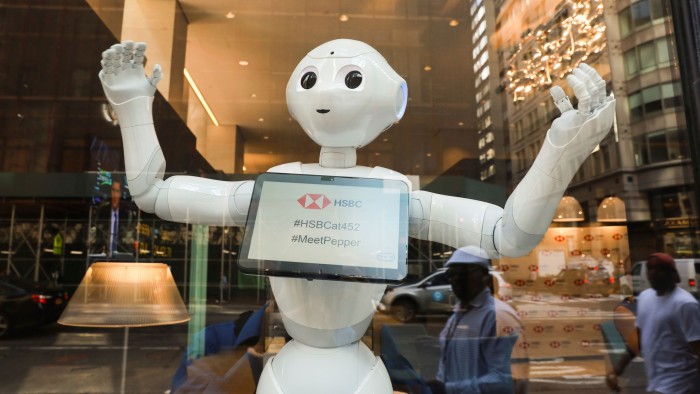Bank chiefs relish prospect of AI boost to productivity

Simply sign up to the Artificial intelligence myFT Digest -- delivered directly to your inbox.
In late 2017, Deutsche Bank’s chief executive at the time, John Cryan, memorably said that robots would replace about half his 98,000-strong workforce over an unspecified timeframe. Weeks later, former Citigroup CEO Vikram Pandit chimed in with a prediction that 30 per cent of global banking jobs could be wiped out by artificial intelligence and robotics within five years.
Both projections have proven overly optimistic, or overly pessimistic, depending on your perspective. Deutsche Bank’s headcount is down just 10 per cent since Cryan’s prediction and that has more to do with routine cost cutting than an AI revolution.
And, while figures on global finance employment are hard to come by, employment numbers in the New York securities industry, for example, rose almost 8 per cent between 2017 and 2022.
Still, hopes for AI’s ultimate impact remain high, albeit grounded more in nuts and bolts productivity gains than earlier sexier use cases — such as HSBC’s robot bank teller Pepper, who was quietly decommissioned around 2019.
“It’s the most profound opportunity for our industry, and for Deutsche Bank, to drive efficiency and to drive automation . . . as well as a significantly better customer engagement experience,” says Deutsche’s chief technology, data and innovation officer Bernd Leukert. “We are clearly ambitious and put this front and centre of our strategy.”
HSBC is similarly effusive, despite the death of its cuddly robot. “I’ve been in many different industries — in aerospace, in telecommunications, in technology — and I actually think financial services is best suited to use AI,” says the megabank’s chief operating officer John Hinshaw. He argues that AI is well placed to bring together the mountains of “legacy technology” that most banks have, and to harness its mammoth piles of data.
He also disputes the idea that financial services’ regulated nature is a “blocker” on AI use — insisting, instead, that it can help fulfil regulatory obligations, especially around financial crime.
Mike Abbott, who heads Accenture’s global banking practice and has spoken to dozens of lenders about their AI initiatives, says banks are in the “first inning” of their journeys, but that large language model capacity is growing at “a rate of 10 [times] a year”. That means big potential gains for those who choose to move quickly.
He says most impact now is around “risk, compliance and enterprise” — with enterprise being a catch-all phrase for HR, legal and other business support functions.
Keri Smith, Accenture’s AI global banking lead, says clients are also using AI as a customer acquisition tool, since banks can offer services in a “more personalised manner” by tailoring promotions based on customer profiles built using AI.
Peter Dugas, who heads regulatory intelligence at consultancy group Capco, is “most excited about being able to [use AI] to analyse thousands of changes to laws and regulations on a global basis”.
He describes how AI could be used to parse rule books, legislation, regulatory guidance and enforcement, and identify what is relevant for an institution.
Capco has already built a tool that can identify about 75 per cent of the records a human would. It has been in conversations with clients about deploying the model for use in regulatory change processes.
Leukert says Deutsche software engineers are using AI to write code better, and faster. With 8,000 to 10,000 engineers writing code every day, the bank is hoping for a “double-digit” percentage productivity boost when it measures the impact of the initiative’s first year, at the end of 2023.
The German lender is also trialling AI to handle staff IT and HR queries, and hopes eventually to use the same technology for some client interactions, subject to regulatory approval.
In investment banking, Deutsche is using AI to augment credit risk models to consider a broader range of non-financial factors, particularly climate related. “It’s a decision support tool, not a decision tool,” Leukert says, though he can imagine AI-enhanced models being used for automated credit decisions, subject to approvals.
Hinshaw says HSBC is already using AI in an anti-money laundering tool that it developed with Google which is now available to the wider financial services industry, as well as for predicting when older ATMs will run out of cash and conducting regular risk reviews of about 400,000 commercial banking loans in the UK.
The former HP executive is optimistic about quantum computing leading to a “step change” in how AI can be used, and the potential for bigger gains with a next-generation workforce that will be “much more ready to embrace AI”.
Then, there is the potential of HSBC’s new London headquarters, which Hinshaw hopes will be AI-enhanced.
He foresees a future where workers — if they have given consent — enter the building, security-pass free. “It [the AI] recognises your face, knows what floor you work on . . . knows what you ordered the last several days for breakfast and reorders it for you,” he says. AI could also identify the most convenient conference rooms for meetings and automatically schedule them.
“This [embracing of AI] is not about job elimination, it’s about . . . doing more with the same number of people and having a more fun place to work in a lot of ways,” he says.

Comments